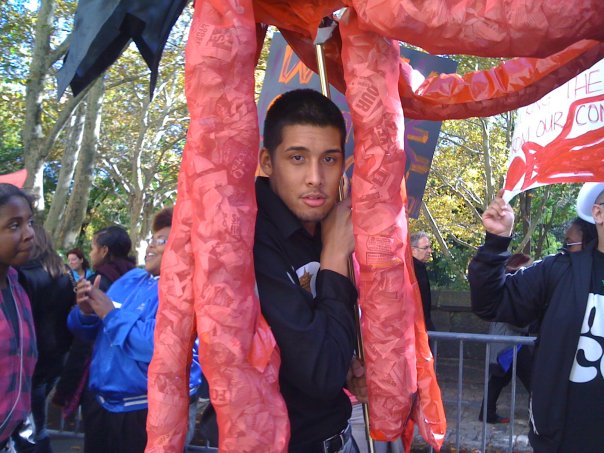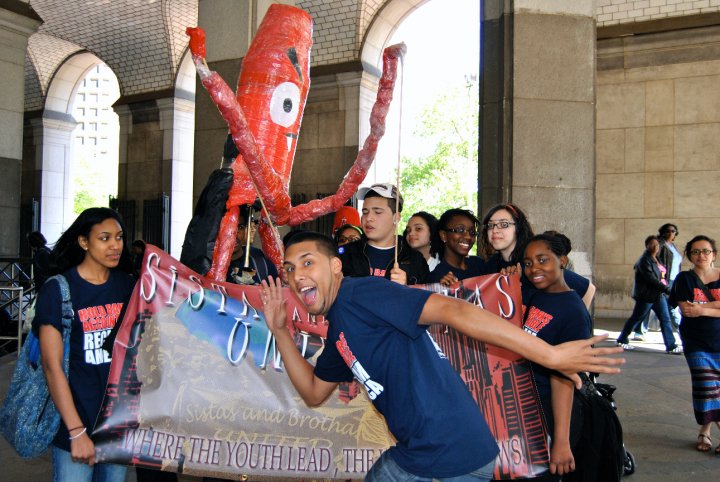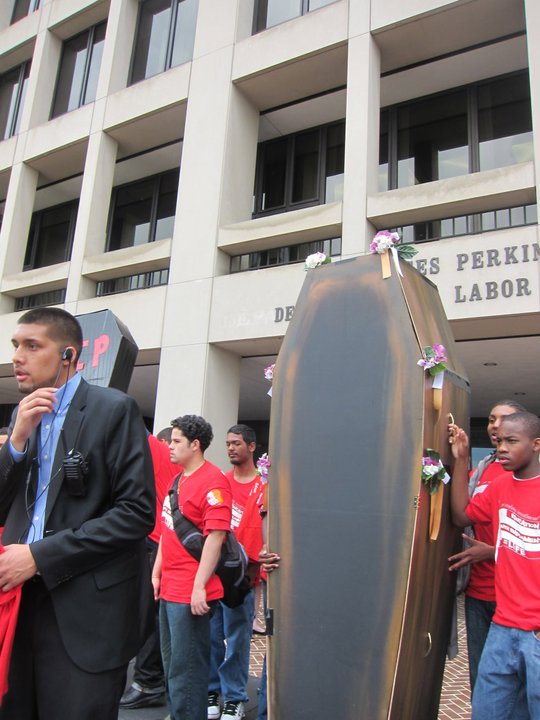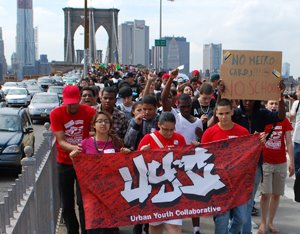This week’s readings were very thought provoking and different from our previous readings focused on CUNY (though more like the Anthony Jack chapter). Harvard occupies such a large place in (inter)national notions of higher education that I wonder whether it makes sense to focus on issues of diversity and access at Harvard, decentering Harvard within the field of higher education, or both simultaneously? While I am critical of many of the logics behind diversity at Harvard, such as meritocracy, I think it’s vital to take into account what the right is doing there as it will have an impact beyond Harvard.
Category Archives: Posts
Week 4 – Miguel Rodriguez “Picture this Test”
Pictures highlight young people (Me) fighting for systemic changes in the NYCDOE, and Federal DOE.
“The collective response from young people who have been misplaced and pushed out”
These photos are a small collection of the moments I was part of social actions targeted at issue directly impacting by high school students. For our next class I hope to share more about what each photo entails especially a it relates to our class readings for the week.




Who thinks Austerity is a good idea? Eve Bromberg
Reading through Austerity Blues, I had a hard time thinking of what an argument for austerity could possibly be. I know I live in a quasi Democratic/Socialist bubble, but how could the erosion of publicly funded good lead to anything but a further reliance on public goods. If you decrease the quality, breath, and depth of public assistance without any policy in place for a transition (i.e.: getting individuals off unemployment via job training or an increase in civil job opportunities), you’re leaving already vulnerable citizens in an increasingly vulnerable position.
I thought about Paul Krugman (currently on the GC’s faculty, I know this is controversial) and what a large Keynesian he is. Increased spending doesn’t just seem like an option for getting over deficits, it seems like the only one.
Public education is a clear investment into the future. An educated (of we could debate what this means and the white supremacist ideal of being “well educated”) population makes for a more productive population (a capitalistic ideal). I’m not advocating that we strive for a high-earning population, but it appears to me, individuals who graduate from college are more likely to find long-term employment and have high earning potential than not. This is to say if we subsidize education, are we not paying it forward? Are we not shepherding in a generation that will go on to be less reliant on public “handouts?”
In a sense, I’m oversimplifying this, and perhaps relying too much on the myth of social mobility, but a BA (or even an Associates) from any university, public or private, increases the number of positions you’re qualified to hold, and you’re in a place where you can continue on to more schooling if that’s of interest.
Keshia – Why the Ranks?
When applying to college undergraduate programs, the first things I considered was whether the program was accredited and affordable. Being in New York City made CUNY my best bet. Next on my list of things to consider was how far away from home the school was and what the support was like for international students to make the transition easier. Medgar Evers College was it for me! A quick 15-minute walk from home and an international students’ group that helped to make the campus feel like home. I had a great social and educational experience at MEC and was able to graduate with my bachelors and teaching certification in 3 years.
It always confused me when friends and family members seem to boast of going to a private college out of state as better than going to a CUNY college or university only to return to the city and hold positions alongside CUNY graduates with much less student debt. The notion of prestige and ranking sadly exists among CUNY colleges as well. In a typical conversation, when asked what school I go to the response was 8 times out of 10, “Oh. Why Medgar?” “Why Brooklyn College or Hunter?” To me they are all CUNY, with different CUNY issues. Same peas, different pods.
What is the logic behind the ranking of CUNY colleges if they are all under the same system? What does it say about CUNY’s leadership if some colleges are considered “better” than others?
In Davidson’s chapter John Mongulescu makes the point that student success after attaining higher education has less to do with the name of the institution than with whether social systems in place that make the jobs and appropriate compensation available. I my view, “how low can higher ed go?” questions the rationale of ranking colleges when at the core the knowledge is the same. Public colleges and universities considered low ranking have produced just as much prestigious individuals in society as ivy league. The ranking then is more of the possible connections that come with being in a particular school which makes higher education more of a popularity or exclusivity contest than about learning.
Troy: Can elitism and access coexist?
When I was 13, after several years of intensive preparation, I was offered scholarships to several of the top independent schools in the city – among them, my number one choice. Though I took pride in knowing my hard work paid off, at the very last minute, I declined the scholarships – disappointing many advisors who had become deeply invested in my academic journey over the years. Many could not understand how I could turn down such a wonderful opportunity. My rationale was simple – even if I was embarrassed to say it aloud at times: I was insecure about my family’s poverty. By my senior year of high school, I had become more comfortable with being poor and I committed to not making my college decision using the same criterion, and I ultimately selected a NESCAC school, like Jack Anthony. With that in mind, the chapters from The New Education by Cathy Davidson and The Privileged Poor by Anthony Jack resonate very strongly with me.
Anthony’s experiences and research elevate themes I recall from my undergraduate experience – understanding the nuances of both the privileged poor and doubly disadvantaged, to one extent or another. And Davidson’s passion for community colleges is impressive. Reading the anecdotes from President Mellow’s description of the LaGuardia Community College student experience is truly inspiring. Though I must say as a mathematician, I find the supposedly common anecdote taken from the 4-year institution with a dean of students stating, “Look to your left. Look to your right. Only one of you will be walking through graduation.” to be a little funny. It is difficult to believe that, somehow, these same 4-year institutions the author previously mentioned being so concerned with their reputations expect to have a 33% graduation rate. Additionally, at one point, preceded by a mention of the lower acceptance rate from 2-year colleges than secondary schools to 4-year colleges, the author states, “College for everyone faces formidable obstacles…” This made me wonder how the author defines college because it seems, based on everything that preceded this statement, that community colleges admitted almost all students and opened doors for so many. So, is college for everyone the issue? Or just 4-year college for everyone?
From these readings, the most important takeaways for me are:
- Selectivity is key for elitism (numbers do not lie).
- Social mobility is a key metric for community colleges, but, in many instances, it is social stability and social standing that are important for many students attending 4-year schools – especially elite ones. Stability and standing can be tough to measure.
- Davidson’s refence to mission reputation being the primary goal for 4-year institutions as opposed to student growth for community colleges is interesting.
- Community colleges have done an amazing job of creating access, which for many demographics that are underrepresented in higher education, is the biggest obstacle.
Week 3 blog post : thoughts on the community colleges
“Today, there are 1,166 community colleges in the United States, and about half of US undergraduates attend community college”(Davidson, p.11).
This is an amazing figure that I’ve never expected. I think the fact that about half of US undergraduates attend community college reveals the significant status of the community colleges in the U.S. Through her book, The New Education, Davidson navigates how the community colleges became established in the US history, the aims of community colleges, the differences between a four-year research university and a community college, etc. From the beginning of the nineteenth century, a community college was intended as an alternative form of post-secondary education, not as a “lesser” institution in the four-year model. Called “junior colleges,” they increased in number from 1909 to 1919. The community colleges were designed specifically to meet the economic challenges of industrialization but with a focus on non-elite students. Some of the community colleges offered several forms of post-secondary training, for example, a teacher’s training.
Although these roles of the community colleges have been changed a bit (no longer a teacher’s training), their position in the community has not changed. A community college centers on the student with low tuition and fees, access to financial aid, academic flexibility and variety, basic literacy and numeracy training, specialized skills-training opportunities based on the specific, and up-to-date occupational requirements of a local community and so on.
Bearing a lot of positive fruits, the community college’s achievements are also numerous. Approximately 44 percent of students with family incomes of less than $25,000 per year go to community colleges directly after high school graduation. Average community college students earn significantly more income over their lifetime than do individuals from the same demographic groups who do not earn either a professional certificate or an associate’s degree. One large-scale study of community college students from six states shows that students completing an associate’s degree earn an average $5,400 a year more than students from the same background who do not complete the degree (Davidson, p.12).
I agree with the idea of the author that we must throw out many of the metrics higher education generally uses, including the bell curve, which dictates a predetermined grade distribution for success and failure. To maintain the identity of the community college, their students shouldn’t be evaluated by their scores or grades they received in their high schools. The community colleges should try to see their student’s potentials toward success, not the present failures they make. Also, the colleges should provide appropriate financial aids to students who want to study, but are not able to afford tuition.
As Manhattan Community College uses a pioneering method of language instruction called a “translingual learning model,” a method that sees multilingualism as a benefit, not a deficit, many colleges in the U.S. ought to invent ways to overcome cultural, racial and financial barriers in their communities.
I have been to LaGuardia Community College in Queens, which is introduced in the book as the epitome of the two-year colleges. Before I entered the GC, I visited the school to get some information about their free classes as a ‘temporary’ immigrant. I wanted to learn something and improve my English because at that time I just began to live in NYC. Unfortunately, my hopeful visit to the college soon turned to disappointment. Although the college’s president, Mellow, said that their students come from over 160 different countries and speak an astonishing 127 native languages, the school seemed not to be prepared to accept a stranger like me. It was difficult to find a place to get the information I wanted regarding the classes they offer, financial aids for immigrants, and so on. In addition, the ESL classes they offered were pretty expensive for immigrants who are looking for a way to take a quality English education. Is LaGuardia Community College really doing great jobs for many new immigrants in NYC? Honestly, I can not agree with that. Therefore, I believe there are still so many things to be done for community colleges to better serve their communities.
Tensions of austerity
I share Cathy Davidson’s love for community colleges. Within CUNY, they continue the tradition of open admissions, carrying on the legacy of the student movement of 1969 and one of the most radical experiments in the history of higher education in the United States, and community colleges across the country open their doors to students who are kept out of baccalaureate institutions.
To a certain degree, I think she paints an accurate picture of community colleges like LaGuardia (which I agree is an exemplary institution). Yes, there are students who overcome great obstacles and make significant sacrifices to become the first in their family to attend college. There are absolutely phenomenal professors, including many who are more pedagogically focused than their senior college counterparts. The student centered peer mentorship programs and exceptional experimental theater productions do exist.
However, decades of austerity have done extreme damage, at CUNY and elsewhere, as Steve Brier and Michael Fabricant make clear. Beneath the exuberance, I think this is present in Davidson’s chapter as well, for example the story of students walking from Flushing to LaGuardia and back could be seen as a policy failure as much as a personal triumph. The tension in this story, and perhaps within and between Austerity Blues and The New Education, is one that exists in CUNY.
I found myself agreeing with a key point made by Davidson (and Mogulescu) and Brier and Fabricant, which is that it really does make a difference how much money is invested in the university, its students, and its workers. ASAP is a clear example of a common sense program (though a nonsensical one in a society dictated by neoliberal common sense) that costs money and achieves its intended results. The decision to cut funding for ASAP (and ACE) then is not due to the program’s failure, but rather it’s mission not being a priority in Albany. Without adequate funding, there’s only so much students, faculty, staff, and administrators can do, something i grapple with as I prepare to TA a seminar this spring at Guttman Community College that is overenrolled with 30 students.
The last point I would like to make is about employment and the purpose of community college and CUNY. Mellow emphasizes that LaGuardia is not a jobs program, and its primary purposes are around critical thinking, citizenship, and humanism—essentially the values guiding a liberal arts education that are often seen as necessary for the rich but not the poor. From a slightly different perspective, Mogulescu concurs, arguing that CUNY does prepare its graduates for the workplace, however their inability to find jobs with decent salaries and benefits is a failure of employment policy and not education policy, a point I agree with. The likes of Cuomo disagree, however, tying student aid and scholarship dollars such as TAP and Excelsior to career oriented courses/majors and post-graduation employment. This brings me to my concluding question: should we highlight CUNY as an engine of social mobility when/if we make arguments for the university, and if so how?
Student Centered Learning Tips (jess)
I really liked Davidson’s ten tips for active, student centered learning and made a little infographic for Tip 1.

Week 3 – D.Torres Response – Is ASAP really the answer?
Community colleges have the arduous task of remediating the long-term, and often times inter-generational educational inequities derived from both public and parochial K-12 school systems. These educational institutions tend to not turn away students based on standardized testing (i.e. SAT, ACT, etc.), but instead accept most with the intention of ameliorating learning gaps. In contrast private universities, such as Columbia University rely on their substantially lower acceptance rates in order to reinforce images of prestige by selecting already high academic performers that will enhance institutional rankings via increased graduation rates. According to US News (2021) Top 100 -lowest acceptance rates for 2019, Columbia’s 5% acceptance rate was second in the nation next to Stanford University. These two different approaches both have their respective benefits and drawbacks. The adoption of different academic measures has also been discussed in both Fabricant and Davidson’s pieces. A push – pull dynamic between institutional management and faculty seems to be common across higher-ed campuses when addressing student related items, such as curriculum development and transfer policies.
Community colleges claim to not “measure their success in supposedly objective measures of “excellence” that typical four-year institutions rely on. I question this proposed altruistic principle that Davidson claims to guide community colleges in only being concerned with “the overall increase of a student’s greater knowledge.” Are these the same set of guiding principles that led CUNY’s own 12% community college graduation rates of the 1990’s and early 2000’s? The rates were so low that the creation of ASAP was necessary in order to address this alarming issue. Even CUNY relies on its own community colleges to serve as feeders into their more prestigious senior colleges. Abductive reasoning leads one to believe that financial factors associated with low graduation rates led to investments in academic research meant to help retain community college students.
Neo-liberal ideologies and principles have become so pervasively entrenched in fields such as healthcare, criminal justice and education that it often goes overlooked within everyday interactions. The over reliance of adjunct faculty and technology, and the commodification of knowledge are all deeply rooted within academia. Fabricant and Bier go on to further explain as to how non-student-oriented business models often clash with faculty governance concerning quality. Unfortunately, there’s no limit in sight as to how low austerity measures can go when using neo-liberal paradigms. The adoption of “bots” to replace financial aid and bursar counselors are an example of the stage of austerity. I’d like to re-imagine a community college graduation ceremony that doesn’t state the intended university that students have committed to transferring too next, but instead emphasizes all of the achieved knowledge and skills.
Follow-up Questions:
- How viable are ASAP’s at CUNY’s senior colleges or external Universities?
- Can institutional leaders be both student and business orientated?
Op-Ed Guides
From Harvard Kennedy School, Communications Program: https://projects.iq.harvard.edu/files/hks-communications-program/files/new_seglin_how_to_write_an_oped_1_25_17_7.pdf
From Columbia University, The Earth Institute: https://www.earth.columbia.edu/help/oped-guide.html


